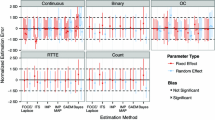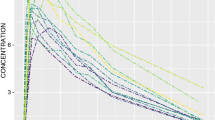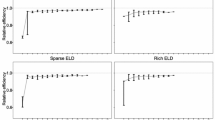Abstract
Here we present a sequential Monte Carlo approach that can be used to find optimal designs. Our focus is on the design of population pharmacokinetic studies where the derivation of sampling windows is required, along with the optimal sampling schedule. The search is conducted via a particle filter which traverses a sequence of target distributions artificially constructed via an annealed utility. The algorithm derives a catalog of highly efficient designs which, not only contain the optimal, but can also be used to derive sampling windows. We demonstrate our approach by designing a hypothetical population pharmacokinetic study, and compare our results with those obtained via a simulation method from the literature.






Similar content being viewed by others
References
Amzal B, Bois FY, Parent E, Robert CP (2006) Bayesian-optimal design via interacting particle systems. J Am Stat Assoc 101:773–785
Bogacka B, Johnson P, Jones B, Volkov O (2008) D-efficient window experimental designs. J Stat Plan Inference 138:160–168
Cavagnaro DR, Myung JI, Pitt MA, Kujala JV (2010) Adaptive design optimization: a mutual information-based approach to model discrimination in cognitive science. Neural Comput 22:887–905
Chib S, Greenberg E (1995) Understanding the metropolis-hastings algorithm. Am Stat 49:327–335
Corana A, Marchesi M, Martini C, Ridella S (1987) Minimizing multimodal functions of continuous variables with the ‘simulated annealing’ algorithm. ACM Trans Math Softw 13:262–280
Dartois C, Lemenuel-Diot A, Laveille C, Tranchand B, Tod M, Girard P (2007) Evaluation of uncertainty parameters estimated by different population PK software and methods. J Pharmacokinet Pharmacodyn 34:289–312
Del Moral P, Doucet A, Jasra A (2006) Sequential Monte Carlo samplers. J R Stat Soc 68:411–436
Demidenko E (2004) Mixed models—theory and application. Wiley series in probability and statistics, 1st edn. Wiley, Hoboken
Duffull SB, Eccleston JA, Kimko HC, Denmanm N (2009) WinPOPT: optimization for population PKPD study design. http://www.winpopt.com. Accessed 1 Aug 2011
Foo LK, McGree JM, Duffull SB (2011) A general method to determine sampling windows for nonlinear mixed effects models with an application to population pharmacokinetic. Pharm Stat. Submitted for publication
Graham G, Aarons L (2006) Optimum blood sampling time windows for parameter estimation in population pharmacokinetic experiments. Stat Med 25:4004–4019
Green B, Duffull S (2003) Prospective evaluation of a D-optimal designed population pharmacokinetic study. J Pharmacokinet Pharmacodyn 30:145–161
Johansen AM, Doucet A, Davy M (2008) Particle methods for maximum likelihood estimation in latent variable models. Stat Comput 18:47–57
Kitagawa G (1996) Monte Carlo filter and smoother for non-Gaussian nonlinear state space models. J Comput Graph Stat 5:1–25
Liu J, Chen R, Wong W (1998) Rejection control and sequential importance sampling. J Am Stat Assoc 93:1022–1031
McGree JM, Drovandi CC, Thompson MH, Eccleston JA, Duffull SB, Mengersen K, Pettitt AN, Goggin T (2012) Adaptive Bayesian compound designs for dose finding studies. J Stat Plan Inference 142:1480–1492
McGree JM, Duffull SB, Eccleston JA (2009) Simultaneous vs. sequential design for nested multiple response models with FO and FOCE considerations. J Pharmacokinet Pharmacodyn 36:101–123
Mentré F, Mallet A, Baccar D (1997) Optimal design in random-effects regression models. Biometrika 84:429–442
Meyer RK, Nachtsheim CJ (1995) The coordinate-exchange algorithm for constructing exact optimal experimental designs. Technometrics 37:60–69
Müller P (1999) Simulation-based optimal design. Bayesian Stat 6:459–474
Müller P, Sanso B, De Iorio M (2004) Optimal Bayesian design by inhomogeneous Markov chain simulation. J Am Stat Assoc 99:788–798
Ogungbenro K, Aarons L (2008) Optimization of sampling windows design for population pharmacokinetic experiments. J Pharmacokinet Pharmacodyn 35:465–482
Ogungbenro K, Aarons L (2009) An effective approach for obtaining sampling windows for population pharmacokinetic experiments. J Biopharm Stat 19:174–189
Pronzato L (2002) Information matrices with random regressors. Application to experimental design. J Stat Plan Inference 108:189–200
Retout S, Mentré F (2003) Further developments of the Fisher information matrix in nonlinear mixed effects models with evaluation in population pharmacokinetics. J Biopharm Stat 13:209–227
Woods DC, Lewis SM, Eccleston JA, Russell KG (2006) Designs for generalized linear models with several variables and model uncertainty. Technometrics 48:284–292
Acknowledgments
We would like to thank both referees for their helpful comments throughout the review process. The authors thank E.G. Ryan for proofreading the paper.
Author information
Authors and Affiliations
Corresponding author
Rights and permissions
About this article
Cite this article
McGree, J.M., Drovandi, C.C. & Pettitt, A.N. A sequential Monte Carlo approach to derive sampling times and windows for population pharmacokinetic studies. J Pharmacokinet Pharmacodyn 39, 519–526 (2012). https://doi.org/10.1007/s10928-012-9265-1
Received:
Accepted:
Published:
Issue Date:
DOI: https://doi.org/10.1007/s10928-012-9265-1




